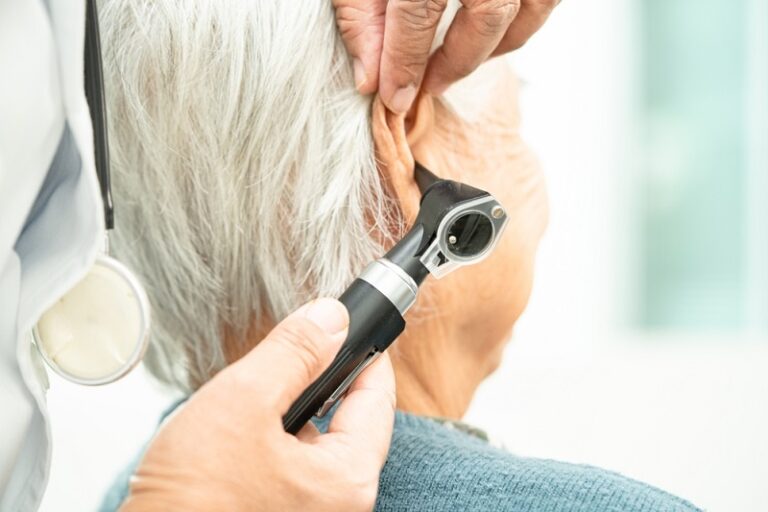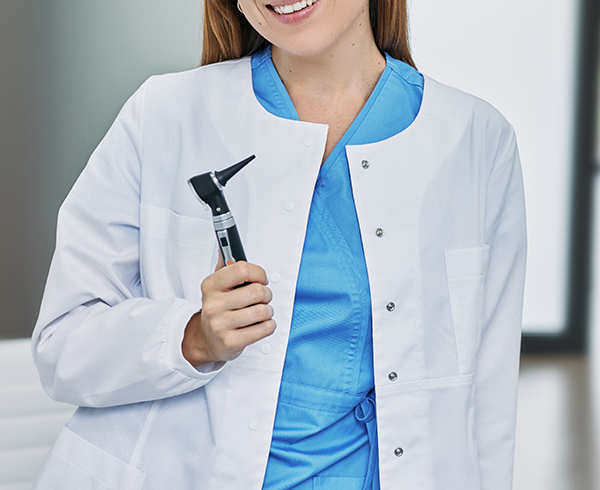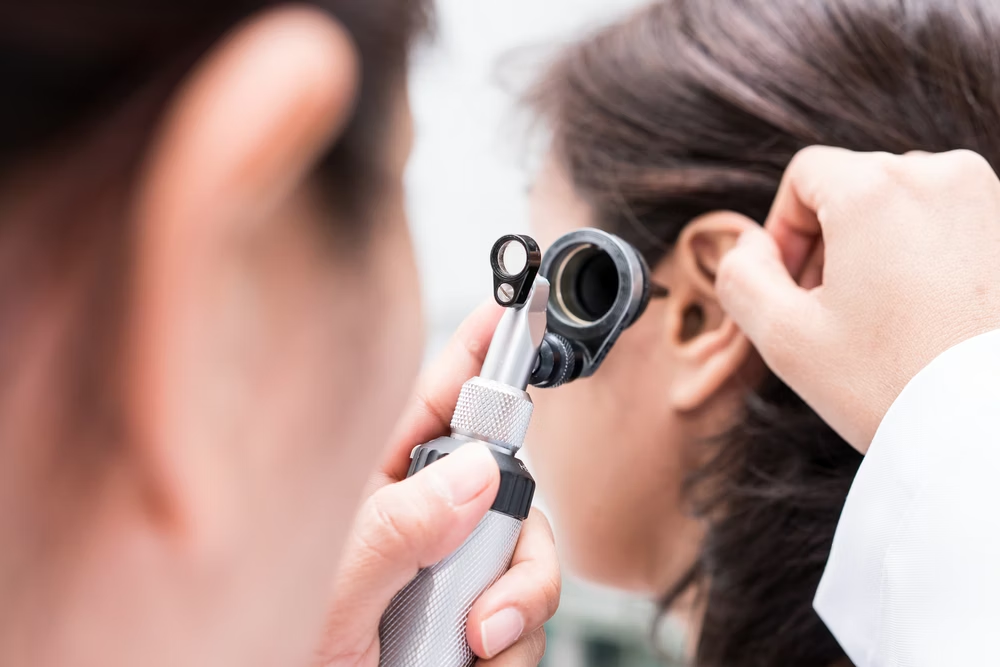Adult & Elderly Hearing Tests
Earlier testing allows for
earlier intervention
Among the different types of ear testing services of our center, making an appointment and participating in professional ear examinations and tests as early as possible is an important part of maintaining auditory health.
Ear examinations and assessments not only help you understand your auditory health as early as possible, but the professionals at the testing center can also provide timely, professional opinions, reports and analyze results, so as to more accurately identify possible auditory problems and help formulate effective solutions to them.
Our center provides one-stop auditory testing and assessments of different kinds, and we are committed to providing customers with the most comprehensive testing results, which helps to assess their current auditory health, or degree of hearing loss, and thus provide timely and timely solutions.

What is an auditory test?
It is a process of assessing an individual’s auditory level, usually through different clinical exams and tests to determine an individual’s auditory sensitivity to different audio frequencies. This type of evaluation or screening is a painless and non-invasive procedure designed to assess a person’s sensitivity to different frequencies of sound.
During testing, different sounds of various frequencies will be played, and the level of the softest sound a subject can hear at each frequency will be measured. This helps medical professionals understand a person’s current condition, so that they can provide appropriate treatment and advice to improve or maintain their auditory health.
As mentioned, the main purpose of testing is to assess an individual’s sensitivity to sound, especially at various frequencies. Typically, these tests are performed by professional audiologists or technicians. They will use specialised equipment to generate sounds of different frequencies to test the auditory range of the person being evaluated. It involves playing a series of sounds, from low to high, and asking the evaluated person to answer or react accordingly to the softest sound they can hear. The results of these tests help doctors determine whether loss in auditory ability is present, as well as the extent and severity of the loss.
For those who may have auditory problems, this evaluation is an important tool in understanding their current health. Through such tests, doctors can develop appropriate treatment plans, such as recommending the wearing of assistive devices, conducting rehabilitation training, or providing other relevant suggestions to improve their quality of life.
The 4 main objective of auditory tests
1. Early detection of auditory problems:
Screening and testing can help detect possible auditory problems early, provide objective data, and form the basis for diagnosing existing conditions. For those who may be experiencing issues, this type of ear testing is an important step in learning more about their current condition and developing treatment plans.

2. Establish treatment plans:
It can also help provide appropriate advice, such as whether assistive devices, rehabilitation, or other measures should be taken to maintain and improve auditory abilities.

3. Identifying causes of issue:
An otoscopic evaluation can assist in identifying potential causes of loss in auditory ability, such as damage to the auditory nerve, abnormal ear structure, infection, or other medical conditions. By gaining a deeper understanding of these causes, a doctor or professional can develop a treatment plan more effectively and provide more precise recommendations.

4. Regular screening for the elderly:
For the elderly, auditory tests are also part of health monitoring, as age may be accompanied by a natural loss in auditory abilities. Through regular ear examinations and tests, age-related issues can be detected and responded to early, and timely support as well as care can be provided.

The professionals at our centre

Audiologists:
An audiologist is a professional who specializes in audiology and has extensive knowledge and skills in evaluating and studying the auditory system. These specialists typically have relevant academic and clinical training to diagnose and treat auditory-related problems.
An audiologist’s job includes performing a variety of screenings and tests, designed to assess an individual’s current auditory health, and determine the presence and nature of any problems if they occur. They can measure the intensity of sound a person can hear in different frequency ranges, as well as detect the presence of hearing loss. Through advanced testing technology and equipment, audiologists are able to provide accurate assessments. In addition, they can design personalized treatment plans, including recommending assistive devices, providing rehabilitation advice, or assisting with other related issues.

Auditory Specialists:
They are technicians with professional training in the field of listening. They play an important role in the assessment and management of auditory problems. These professionals have considerable expertise and skills that enable them to perform some basic tests and examinations.
These specialists often play a role on the auditory care team, assisting in determining an individual’s current status. They may be responsible for performing an initial screening or test to assess the person’s auditory health. These screening tests can help identify potential problems. In addition, these specialists may also assist in the installation and adjustment of assistive devices, provide basic maintenance and adjustments of assistive products, and design personalized treatment plans, such as recommending the use of such assistive products and providing other types of solutions to users.
When conducting tests for the elderly, the professionals at our testing center use a variety of auditory measurement tools and equipment, for example, earpieces, sound playback equipment, and professional soundproof testing rooms. Our audiologists or technicians will select appropriate testing methods based on individual needs and symptoms to fully evaluate auditory function. They understand the anatomy and physiology of the auditory system and can identify various factors that may contribute to auditory problems. Before an ear examination or test, there is usually some preliminary consultation to understand the individual’s current status, symptoms and lifestyle. After that, our professionals will develop a testing plan based on this information to provide an accurate assessment and diagnosis.
Different kinds of evaluations & assessment methods
-
1. Pure tone assessment:
-
2. Sound resistance test:
-
3. Otoacoustic emission ear test:
-
4. Auditory brainstem response testing:
-
5. Speech test:
-
6. High frequency test:
Our tests for the elderly include a pure tone test, which is a comprehensive and accurate ear test service. This test provides a comprehensive assessment of the auditory levels of the customer's left and right ears at different frequencies, ranging from 250 to 8000 Hz. This multi-frequency ear testing range ensures sensitivity to different pitches, helping to identify any potential problems.
Elderly guests undergoing this test will typically wear headphones in a soundproof room. This ear test procedure is to ensure that the assessment environment is quiet and to eliminate interference from external noises. By pressing buttons to indicate sounds heard, guests actively participate in the whole process. This assessment can also help determine the degree of any loss in auditory abilities, and so it is critical to the selection of individually customized assistive devices.
Pure-tone assessment includes the “pure-tone audiometry”, also known as “air conduction audiometry”, which is a common test method used to evaluate the auditory sensitivity of the person to different tones and volumes. In this kind of pure tone audiometry test, our professionals will utilise headphones or earplugs to play a series of pure tones of different audio frequencies and intensities to the examined. The subject needs to listen and respond to the played sound, usually by pressing a given button or raising a hand. After recording their responses, professionals can then determine a person's listening threshold, which is the softest sound that can be heard. Pure tone audiometry assessments are a safe, non-invasive and reliable method of testing your auditory health.
On the other hand, “bone conduction testing” is another type of test used in this field. Professionals will use a tape with a metal vibrator attached (called bone vibration test), and place it on the bone behind the client's ear. The hearing of the internal auditory canal is measured by conducting sound through the skull to the inner ear through vibration. Bone conduction testing is a common assessment method, especially useful for detecting air conduction hearing loss caused by ear canal obstruction or other problems. During this test, the person taking the test will typically feel slight vibrations rather than recognising sounds through traditional headphones. This test method helps professionals at our center more accurately assess the current function of the inner ear. Typically, bone conduction testing is used in conjunction with other testing methods to provide a comprehensive assessment of a person's current auditory health.
This is a comprehensive ear examination, which mainly includes tympanic examination and auditory reflex examination. The purpose of this test is to evaluate the condition of the eardrum and middle ear of the person undergoing the ear test.
In such a test, the ear canal of the subject undergoing the test will be moderately pressurized to observe the swing of the eardrum, which causes the eardrum to swing forward or backward, providing important information about the function of the middle ear. On the other hand, the auditory reflex test requires the subject to listen to louder sounds to check the involuntary muscle contraction response in the ear. This assessment helps assess the auto-regulatory mechanism of the subject’s middle ear, providing a more comprehensive picture of their auditory health.
This is a method that provides an in-depth understanding of the inner ear health of the subject. It mainly focuses on evaluating the function of inner and outer hair cells of the subject, through a series of continuous sound stimulations to observe the reactions and conditions within the cochlea.
During testing, the subject will hear sounds of different frequencies and intensities through the testing equipment. The outer hair cells in the cochlea will respond to these sounds, producing what are called "otoacoustic emissions." These responses of the subject will be automatically recorded and analyzed by the instrument, providing valuable information for evaluating the inner ear health status of the subject. Through otoacoustic emission testing, professionals can have a more comprehensive understanding of the function of the patient's inner ear, and detect whether there are potential problems or abnormalities. This test enables early detection and treatment of possible auditory problems, providing a better chance of timely care for the subject.
Auditory brainstem response testing, is also known as auditory steady-state response testing. This test observes the entire transmission speed of the auditory signal from the cochlea to the brainstem. This test can evaluate the auditory abilities and degree of loss of auditory abilities of a subject, as well as the integrity of the auditory nerve function.
During testing, the subject needs to remain relaxed or asleep and have several sensor patches attached to their head. These sensor sheets are used to record the brain wave response of the subject’s brainstem to the sounds of the test to provide important information about auditory signal transmission speeds and brain response. This test helps to gain an in-depth understanding of the auditory health of a patient, especially for the elderly.
This is an audiometric test conducted to evaluate the subject's speech recognition ability in Chinese or English. This test not only helps evaluate the subject’s speech recognition level, but also provides valuable information to help professionals gain a deeper understanding of the recipient's current health.
The subject puts on earphones, then listens to and repeats the words heard. The professionals can then observe their reaction when facing the speech signal, and then confirm their perception of specific speech frequencies and pitches. This test allows the professionals at our center to conduct a comprehensive examination to evaluate the subject’s auditory performance in multiple contexts. What’s more, this assessment is also critical for daily communication and language understanding, and provides more data to develop personalized intervention plans.
The purpose of the test is to evaluate the subject's ability to hear high-frequency sounds (9000 to 20,000 Hz). The test procedure involves placing the subject in a soundproof room, asking them to put on earphones, and then undergo a high-frequency ear test. During testing, subjects will hear a series of high-frequency pure tones (9000 to 20,000 Hz). Each time they hear a sound, they are required to raise their hands or press a button for statistics and evaluation purposes. This helps us gain a more comprehensive understanding of the subject's auditory performance in the higher-frequency sound range.
In these tests, the process is similar to that for general adults or the elderly, including a pure tone auditory ability test. The elderly who undergo this test, will be arranged to wear earphones in a soundproof room, which helps ensure a quiet environment. Through the sounds of different frequencies emitted by the pure tone tester, the professionals can evaluate the minimum threshold of the subject. This behavioral assessment requires the person to press a button when a sound is heard to determine the person's auditory abilities and response.
Elderly hearing evaluation & screening
Auditory tests for the elderly are designed to assess their auditory responses to different audio frequencies. Elderly ear tests are an important assessment tool designed to help them detect and manage possible auditory problems early on. These types of tests will be performed by the professionals at our center, including by our audiologists and technicians.
The audiologists at our center will use a variety of assessment methods and tools to measure the auditory function of the elderly. Testing typically includes an assessment of auditory perception of sounds of different frequencies and volumes, as well as a test of speech understanding. Through these tests, our professionals can evaluate the current auditory health of the elderly, as well as determine whether there is a loss in ability, and understand the type or extent of the loss.
Such an assessment can help develop an individualized treatment plan, including the use of assistive products or other devices, and provide rehabilitation and education. Through regular testing and screening, the elderly can receive necessary support and intervention measures in a timelier manner, thus greatly improving their quality of life and independence.
Our center has an in-depth understanding of the needs of each client who undergoes our elderly ear tests, and we strive to provide personalized treatment plans based on the test results, which can include recommendations for adopting assistive devices, as well as thoughtful medical advice that enable the elderly to better cope with everyday challenges.
We are not only committed to providing comprehensive ear testing services, but also aim to provide comprehensive services of support and solutions for patients. Our staff are committed to assisting test clients achieve better auditory health, while improving their quality of life.
We recommend that seniors should have their ears tested at least once a year to ensure that any potential auditory problems are detected and dealt with at an early stage. Our auditory abilities may gradually decline as we age, so regular check-ups are key to detecting and treating such problems early.
Through regular testing, the elderly can understand their current auditory health at any given time and take necessary measures if needed. In addition, seniors can consider adjusting the frequency of testing based on their personal circumstances and needs. For example, if an elderly person has previously had auditory problems, or is currently using assistive listening devices, more frequent evaluation or screening may be needed to ensure the treatment plan is still relevant. Furthermore, if the elderly are frequently exposed to noisy environments in daily life, such as in the workplace or in recreational activities, it is also recommended to pay closer attention to their auditory health and undergo regular testing.

More about ear tests – FAQs:
Generally, no special preparation is required before taking a test. But on the day of your ear test, make sure your ears are clean for the most accurate results. Before taking a test, guests will gain an understanding of the various processes that will be encountered, which will help understand its purpose.
Secondly, if you have had an auditory test before, review past test reports and results, as well as any recommendations or treatment options. This will help provide more comprehensive information so our centre can better understand your current condition.
On test day, it's equally important to keep a relaxed mind and a positive attitude. Our professionals’ goal is to help you understand your current auditory health. If you are unsure about anything during the test, please ask our professionals and they will be happy to answer any questions and provide professional explanations.
Finally, after the test is done, our professionals will explain to you the results, including any potential auditory problems or recommended solutions. This will help you better understand your test results and may provide guidance on future care.
The day before your test appointment, the receptionist at our test center will warmly remind you of your upcoming appointment through phone call and text message, and will also confirm with you the appointment time and center address.
After arriving at our center, if the customer is joining us for the first time, please follow the instructions of the receptionist and fill in the customer's basic personal information, as well as a simple questionnaire about your ear and auditory conditions. At this step, if you have any doubts or inquiries, please contact our staff. The professionals at our center will be very happy to provide the best service they can. After completing the personal information form, please wait patiently. Our professionals will then ask you to enter the test room. These test rooms are generally quiet and soundproof spaces to ensure that you are away from any noise, which helps with the accuracy of the test.
After that, our professionals will then follow up with you on some information about your ears and current auditory abilities that you have filled out on the form to get a more complete understanding. Next, our professionals will examine your ears using an otoscope, a speculum shaped like a funnel commonly used to examine the external auditory canal and eardrum. This cone-shaped instrument is equipped with a light source at one end to help examine the inside of the ear for any organic problems and to ensure there are no blockages or other issues that could affect the accuracy of the test.
During testing, our professionals may also ask about your medical history, recent symptoms of loss in auditory abilities, general health status, and past exposure to chemicals at work and outside of work. After completing the test, our staff will explain to you the results of your test, as well as any recommended treatment or intervention methods. They will explain what the test results mean, answer any questions you may have, and work with you to develop a tailored plan of treatment and intervention.
These tests are very safe, and most people experience no discomfort. The sounds during the test are usually played in a quiet environment and adjusted according to each person's condition to ensure their comfort. Ear testers also follow strict standard procedures to minimize any factors that may cause discomfort. If you are worried about the ear test or have any doubts, please communicate with us in advance. Our experts can then explain the entire test process in detail and answer any questions you may have.
The test results will show your auditory sensitivity to different frequencies in the form of an audiogram. Our professionals will explain your test results, discuss any possible concerns, and work with you to develop a personalized treatment and intervention plan tailored to your individual needs.
An audiogram is an important diagnostic tool. It provides detailed information about an individual's auditory sensitivity. By analyzing the audiogram, our professionals can determine the type and extent of a client's loss of auditory abilities. For example, if the audiogram shows large thresholds at low frequencies but normal thresholds at high frequencies, it may indicate that the patient has low-frequency sensorineural loss of auditory abilities.
Additionally, an audiogram may help determine the cause of loss of auditory abilities, such as due to noise exposure or ear diseases. Based on the audiogram results, our professionals can develop a personalized treatment plan, such as recommending the use of assistive products, auditory rehabilitation training, etc.
An audiogram is often used to indicate a person's auditory sensitivity to sounds of different frequencies and volumes. Regarding the interpretation of the audiogram, the horizontal axis (x-axis) represents the frequency of the sound, usually in Hertz (Hz), arranged from low frequency to high frequency. The vertical axis (y-axis) represents the intensity or volume of sound, usually in decibels (dB), arranged from quiet to loud sound volume. Through audiograms, our professionals can understand your auditory ability at different frequencies and volumes, thereby diagnosing any loss in that ability, and develop appropriate treatment plans.
